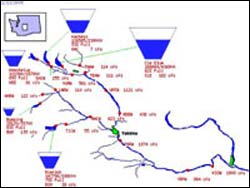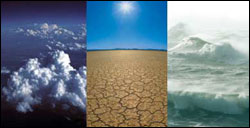Volcanic eruptions in Siberia 251 million years ago may have started a cascade of events leading to high hydrogen sulfide levels in the oceans and atmosphere and precipitating the largest mass extinction in Earth’s history, according to a Penn State geoscientist.
“The recent dating of the Siberian trap volcanoes to be contemporaneous with the end-Permian extinction suggests that they were the trigger for the environmental events that caused the extinctions,” says Dr. Lee R.
Typical economic analysis applied to global warming may be biased because they neglect climate thresholds, according to Penn State researchers.
“Economic models of climate change typically assume that changes occur gradually and reversibly,” says Dr. Klaus Keller, assistant professor of geoscience, Penn State. “However, some environmental effects are not smooth and show a threshold response. For a long time nothing or very little happens and then suddenly a large change occurs.”
Surrounded by winter snow and ice, melting seems like a good thing, but, on a global scale, the melting of ice sheets and glaciers is a sign of global warming, according to a Penn State glaciologist.
“The really big picture shows change in the ice and those changes look like what we get is a world that is a little warmer,” says Dr. Richard B. Alley, the Evan Pugh Professor of Geosciences. “We currently do not include all these processes in the models that predict the global future.

El Niño’s effects on a Pacific Northwest river valley offer forecasters a window to dry years ahead
Global warming conversations have shifted from whether climate is changing to how we will deal with the inevitable consequences. And the price you pay will depend on where you live and how well you prepare, suggests one of the most detailed studies to date on global warming and its likely effect on human activity.
“Like politics, global climate change is local,” said

Climate warming likely to impact water resources in regions around the globe
Scientists at Scripps Institution of Oceanography at the University of California, San Diego, and their colleagues have produced the first clear evidence of human-produced warming in the world’s oceans, a finding they say removes much of the uncertainty associated with debates about global warming. In a new study conducted with colleagues at Lawrence Livermore National Laboratory’s Program for Cl
Around 60 nations and more than 40 international organisations joined ESA and host the European Community at the Third Earth Observation summit on Wednesday. History was made at the Palais d’Egmont in Brussels as assembled delegates formally agreed a ten-year plan to implement a Global Earth Observation System of Systems.
The plan summarises the steps that need to be taken to put a Global Earth Observation System of Systems (GEOSS) in place. GEOSS will build on existing Earth